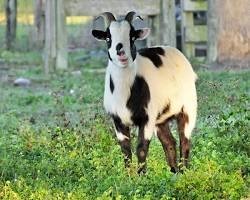 |
| Source: www.thoughtco.com |
Tennessee Fainting Goats are also known as Myotonic, Tennessee
Meat, Texas Wooden Leg, Stiff, Nervous, and Scare goats.
The breed's history can be traced
back to the 1880s. An itinerant farm laborer named John Tinsley came to central
Tennessee, reputedly from Nova Scotia. Tinsley had with him four unusual, stiff
goats. Goats of this type gradually became known across the region. They were
less apt to climb fences and escape from pastures than other goats, and their
muscular conformation and high reproductive rate were also valued. Farmers
began to appreciate them, and the numbers of "stiff,"
"nervous," or "fainting" goats increased. During the 1950s,
some Tennessee Fainting goats were taken to the hill country of central Texas. They
were further selected for meat qualities, including larger size, and came to be
known as "Wooden Leg" goats.
In the late 1980s, both the
Tennessee and Texas branches of this breed were rediscovered. The new
enthusiasm for the goats diverged into two major endeavors. One group of breeders
worked in the historic tradition, emphasizing the meat qualities of the animals
and selecting for growth rate, conformation, and reproductive efficiency. The
other group selected for extreme stiffness and small size, promoting the breed
as a novelty animal.
As a landrace breed, Tennessee
Fainting goats were always variable in size. This variability, emphasized by
recent selection, has given rise to a population, which ranges in weight from
60-175 pounds. Heavily muscled conformation is consistent among the goats. The
ears of Tennessee goats are larger and more horizontal than Swiss breed goats,
but smaller and less drooping than Nubian or Spanish goats. The facial profile
is usually concave. Most goats are horned, and horns vary from large and twisted
to small and simple. While most of the goats have short hair, long-haired goats
are not unusual and some animals produce cashmere.
Tennessee Fainting goats are found
in almost all colors known in goats. Kidding season is always exciting, as new
color combinations pop up. Since does like to keep their kids hidden for a few
days, looking for these multicolored kids can be like hunting Easter eggs. Does
are prolific, with an extended breeding season, and some does will bear kids
every six months. Most does produce twins or triplets regularly and have plenty
of milk to raise them.
The Tennessee Fainting goat breed
is gaining attention for its combination of meat traits with reproductive
efficiency, and it is increasingly recognized as an important genetic resource
in the United States. Goats are being used both as purebreds and for crossing
with other breeds, especially the Boer goat, a recent import from South Africa.
While crossbreeding can demonstrate the genetic value of the Tennessee Fainting
goat, overuse of purebred does for crossing would threaten the survival of this
unique and important American goat breed. It is a high conservation priority.


